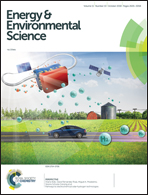Zero-strain K0.6Mn1F2.7 hollow nanocubes for ultrastable potassium ion storage†
Abstract
Potassium-ion batteries (KIBs) are an attractive energy storage system due to their advantages of low cost and abundant potassium resources. However, their rapid development is greatly impeded by their low capacity and poor stability, due in particular to their much larger volumetric expansion compared to transition metal lithium-ion batteries. Herein, we report a new etching route to fabricate a new class of zero-strain potassium fluoromanganate hollow nanocubes (KMnF-NCs) for boosting the performance of KIBs in terms of capacity, rate capability and cycling stability. The as-made KMnF-NCs containing rich K and F vacancies exhibit a high capacity and super high stability by showing a specific capacity of 110 mA h g−1 even after 10 000 cycles, which is the best stability for KIBs. In situ X-ray diffraction and the first-principles calculations reveal a new storage mechanism for KIBs, in which the intercalation/deintercalation of K ions into/from the K and F vacancies (as a battery behavior) and the adsorption/desorption onto/from the surface (as a pseudocapacitance characteristic) are the key to increasing the capacity of KIBs. Most importantly, we found that during the discharge process, the volume expansion of the etched KMnF-NC was only 1.4%, which is much lower as compared to well-known negative materials, showing great potential as a new class of high-performance zero-strain negative materials for KIBs.



 Please wait while we load your content...
Please wait while we load your content...